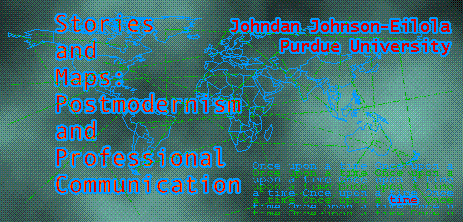Stories and Maps

bio
Johndan Johnson-Eilola teaches in the Rhetoric and Composition program at Purdue University. He has published work on computers and communication in Computers and Composition, Collegiate Microcomputer, Journal of Advanced Composition, Writing on the Edge, Technical Communication, and IEEE Transactions on Professional Communication, as well as in edited collections. His book on the politics of hypertext genres, Nostalgic Angels: Rearticulating Hypertext Writing will be published in 1997 by Ablex Press.
abstract
In this text, I sketch out some of the ways that postmodernist tendencies affect the careers and possibilities for business and technical communicators. Communication used to be about telling stories, about listening to narratives of discovery, learning, redemption, and war. Not just little stories, but big stories: heaven, hell, utopia. Relatively recently, though, the map has started to replace the story as our fundamental way of knowing. The new emphasis on spatial rather than temporal or historical concerns goes by a number of titles--postcapitalism, networked workplaces, nonhierarchical management--but the most popular (and often misunderstood) is postmodernism. Briefly, I see the potential for increased responsibility, prestige, and influence for business and technical communicators, but only if we are able to reconceive what we think of as the value of our work; that is, we must reposition ourselves as mapmakers rather than authors.
navigational advice
You can click the [next] buttons and make a quick run through the text, although doing that will skip over a third to half the nodes, I think. You can also look at the [map] node, which you can get to from nearly any other node. (But that only contains the main, [next]-thread nodes.) My strongest suggestion is to read multilinearly and multiply. I'm not comfortable (as I say in the text) with providing a single reading on the text--that would be no better than a hierarchical text.
Front node of Kairos 1.1 archived version of this hypertext.
Author's active front node of this hypertext..
This web was peer-reviewed by Jeff Galin and Richard Selfe.

